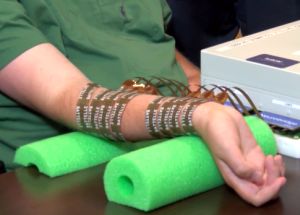24 June 2014. Engineers at Battelle Memorial Institute and physicians at Ohio State University medical center in Columbus demonstrated a device that enables people with a spinal cord injury to direct movement of limbs with their thoughts. The research team’s first patient is Ian Burkhart, a 23 year-old man from Dublin, Ohio taking part in a proof-of-concept clinical trial of Battelle’s Neurobridge technology at Ohio State.
The Neurobridge system uses a chip about the size of a pea, implanted in the patient’s motor cortex, the part of the brain that controls voluntary movements. The chip reads and transfers signals from the brain to an external computer that recodes brain signals into electrical impulses for controlling a sleeve worn on the wrist. The sleeve contains electrodes that stimulate muscles in the patient’s hand and wrist muscles to perform the movements directed by the captured thoughts.
Burkhart became a quadriplegic four years ago in a diving accident, and is the first of five patients taking part in the clinical trial. He had to take part in months of rehabilitation with the electrode sleeve to first rebuild the atrophied muscles in his forearm, before receiving the brain-chip implant, in surgery at Ohio State on 22 April 2014.
Battelle says it took nearly a decade to develop the system, which includes complex algorithms and software, as well as the electrode sleeve worn by the patient. The institute’s engineers, led by Chad Bouton, worked with the Ohio State medical center team led by neurosurgeon Ali Rezai and physical medicine and rehabilitation chair Jerry Mysiw to design the clinical trial. Rezai is principal investigator of the trial.
“We’re taking those signals from the brain, going around the injury, and actually going directly to the muscles,” says Bouton in Battelle statement. Similar research efforts to capture and translate a patient’s thoughts into electronic instructions use robotics to move the paralyzed patient’s limbs. The researchers say this is the first system to translate brain signals into electrical impulses that stimulate motor activity.
Advances in rehabilitation technology are helping make Burkhart more hopeful. “It’s definitely great for me to be as young as I am when I was injured,” says Burkhart, “because the advancements in science and technology are growing rapidly and they’re only going to continue to increase.”
The following video shows the demonstration and tells more about the Neurobridge system.
- Challenge Seeks Methods to More Accurately Detect Epilepsy
- Medical Centers to Develop Brain Signal Tracking, Therapies
- Alzheimer’s Brain Stimulation Implants Completed for Trial
- Sense of Touch Restored to Amputee’s Prosthetic Hand
- Neurotherapies Require Collaboration, Team Science, Big Data
* * *


 RSS - Posts
RSS - Posts
You must be logged in to post a comment.